Introduction
As an initial summary, we recommend the following key points when evaluating a patient with a thyroid mass:
Confirm whether the mass is intrathyroidal or extrathyroidal. Clues from the history, the physical examination, and imaging (ultrasound and/or CT) can help in differentiating between the two.
Cervical ultrasonography is the preferred initial test of choice for evaluating the structure and anatomic location of a neck mass, and for assessing the presence of features that may increase clinical suspicion about the mass.[2]Gharib H, Papini E, Garber JR, et al. AMERICAN ASSOCIATION OF CLINICAL ENDOCRINOLOGISTS, AMERICAN COLLEGE OF ENDOCRINOLOGY, AND ASSOCIAZIONE MEDICI ENDOCRINOLOGI medical guidelines for clinical practice for the diagnosis and management of thyroid nodules - 2016 update. Endocr Pract. 2016 May;22(5):622-39.
https://www.endocrinepractice.org/article/S1530-891X(20)42954-4/fulltext
http://www.ncbi.nlm.nih.gov/pubmed/27167915?tool=bestpractice.com
[38]National Institute for Health and Care Excellence. Thyroid disease: assessment and management. Oct 2023 [internet publication].
https://www.nice.org.uk/guidance/ng145
[33]American College of Radiology. ACR–AIUM–SPR–SRU practice parameter for the performance and interpretation of diagnostic ultrasound of the thyroid and extracranial head and neck. 2022 [internet publication].
https://www.acr.org/-/media/ACR/Files/Practice-Parameters/ExtracranialHeadandNeck.pdf
It is cost-effective and does not expose the patient to ionizing radiation.
Cervical lymph nodes should always be evaluated ultrasonographically when a thyroid nodule is being assessed.[1]Haugen BR, Alexander EK, Bible KC, et al. 2015 American Thyroid Association management guidelines for adult patients with thyroid nodules and differentiated thyroid cancer. Thyroid. 2016 Jan;26(1):1-133.
https://www.ncbi.nlm.nih.gov/pmc/articles/PMC4739132
http://www.ncbi.nlm.nih.gov/pubmed/26462967?tool=bestpractice.com
If they have signs of malignancy (microcalcifications, cystic aspect, peripheral hypervascularity), ultrasound-guided needle aspiration biopsy should be performed.[1]Haugen BR, Alexander EK, Bible KC, et al. 2015 American Thyroid Association management guidelines for adult patients with thyroid nodules and differentiated thyroid cancer. Thyroid. 2016 Jan;26(1):1-133.
https://www.ncbi.nlm.nih.gov/pmc/articles/PMC4739132
http://www.ncbi.nlm.nih.gov/pubmed/26462967?tool=bestpractice.com
If the mass or nodule arises from the thyroid gland, assess whether the mass is hormonally active.[3]Alexander EK, Cibas ES. Diagnosis of thyroid nodules. Lancet Diabetes Endocrinol. 2022 Jul;10(7):533-9.
http://www.ncbi.nlm.nih.gov/pubmed/35752200?tool=bestpractice.com
The history, physical examination, and paired free T4 and thyroid-stimulating hormone (TSH) measurements are used to assess the functional status of the lesion.
Diffuse, non-nodular thyroid masses may be a result of thyroiditis or lymphoma and evaluation depends on the severity of symptoms, rate of progression, and sonographic appearance of the lesion.
Ultrasound features alone are not sufficient to exclude or confirm malignancy. For thyroid nodules that require definitive diagnosis, ultrasound-guided fine needle aspiration (FNA) should be performed when this knowledge would be clinically impactful. Appropriate subsequent management can be guided by cytology results. Current guidance discourages routine biopsy of thyroid nodules less than 1 cm.[1]Haugen BR, Alexander EK, Bible KC, et al. 2015 American Thyroid Association management guidelines for adult patients with thyroid nodules and differentiated thyroid cancer. Thyroid. 2016 Jan;26(1):1-133.
https://www.ncbi.nlm.nih.gov/pmc/articles/PMC4739132
http://www.ncbi.nlm.nih.gov/pubmed/26462967?tool=bestpractice.com
[2]Gharib H, Papini E, Garber JR, et al. AMERICAN ASSOCIATION OF CLINICAL ENDOCRINOLOGISTS, AMERICAN COLLEGE OF ENDOCRINOLOGY, AND ASSOCIAZIONE MEDICI ENDOCRINOLOGI medical guidelines for clinical practice for the diagnosis and management of thyroid nodules - 2016 update. Endocr Pract. 2016 May;22(5):622-39.
https://www.endocrinepractice.org/article/S1530-891X(20)42954-4/fulltext
http://www.ncbi.nlm.nih.gov/pubmed/27167915?tool=bestpractice.com
[18]Garber JR, Papini E, Frasoldati A, et al. American Association of Clinical Endocrinology and Associazione Medici Endocrinologi thyroid nodule algorithmic tool. Endocr Pract. 2021 Jul;27(7):649-60.
https://www.endocrinepractice.org/article/S1530-891X(21)00164-6/fulltext#secsectitle0130
http://www.ncbi.nlm.nih.gov/pubmed/34090820?tool=bestpractice.com
Diagnostic lobectomy (hemithyroidectomy) should be considered for definitive histologic diagnosis following two or more unsatisfactory or indeterminate FNA biopsies; these patients have a higher risk of malignancy than the general rate for all thyroid nodules.[1]Haugen BR, Alexander EK, Bible KC, et al. 2015 American Thyroid Association management guidelines for adult patients with thyroid nodules and differentiated thyroid cancer. Thyroid. 2016 Jan;26(1):1-133.
https://www.ncbi.nlm.nih.gov/pmc/articles/PMC4739132
http://www.ncbi.nlm.nih.gov/pubmed/26462967?tool=bestpractice.com
The following sections explain the diagnostic approach in more detail.
History
Most thyroid nodules are asymptomatic. However, the patient should be evaluated for symptoms of hypothyroidism or hyperthyroidism and for local compressive symptoms such as dysphonia, dysphagia, and dyspnea.
Symptoms of hyperthyroidism include irritability, increased perspiration, heat intolerance, palpitations, tremors, anxiety, insomnia, fine brittle hair, frequent bowel movements, and weight loss. Symptoms of hypothyroidism include cold intolerance, constipation, weight gain, fatigue, and dry and itchy skin.
Factors that increase the likelihood of malignancy are the following:[39]Hegedüs L. Clinical practice: the thyroid nodule. N Engl J Med. 2004 Oct 21;351(17):1764-71.
http://www.ncbi.nlm.nih.gov/pubmed/15496625?tool=bestpractice.com
Male sex
Age at presentation <20 years or >60 years
History of rapid growth
Prior head and neck irradiation (therapeutic, industrial/occupational, or from environmental release from a nuclear accident)
Dysphonia/hoarseness
Familial history of medullary thyroid carcinoma, other thyroid cancer, multiple endocrine neoplasia, or Cowden syndrome.
Physical examination
Physical examination involves performing a detailed assessment of the thyroid mass and any associated lymphadenopathy, evaluating whether the patient has signs of hypothyroidism or hyperthyroidism and evaluating whether the surrounding structures (trachea and esophagus) are compressed.
Examination must include inspection and palpation of the anterior and lateral aspects of the neck to assess for thyroid enlargement, presence of nodules, and lymphadenopathy. Asking the patient to swallow during palpation, which elevates the thyroid, can improve the palpation of the thyroid gland and detection of nodules. The signs of hyperthyroidism include tachycardia, arrhythmias, muscle wasting, tremor, brisk reflexes, and brittle hair. The signs of hypothyroidism include bradycardia, thickened and puffy appearance of skin (myxedema), and delayed relaxation phase of reflexes.
Visualization of vocal fold movement is very important if the patient presents with dysphonia. This can be done with a dental mirror and a headlight, an ultrasound exam, or with a flexible nasopharyngoscope (the definitive test).[40]Maher DI, Goare S, Forrest E, et al. Routine preoperative laryngoscopy for thyroid surgery is not necessary without risk factors. Thyroid. 2019 Nov;29(11):1646-52.
http://www.ncbi.nlm.nih.gov/pubmed/31333068?tool=bestpractice.com
A paralyzed vocal cord ipsilateral to the thyroid mass is a concern for an invasive thyroid cancer. Current American Academy of Otolaryngology-Head and Neck Surgery guidelines recommend laryngeal examination for patients with a neck mass deemed at increased risk for malignancy.[41]Pynnonen MA, Gillespie MB, Roman B, et al. Clinical practice guideline: evaluation of the neck mass in adults. Otolaryngol Head Neck Surg. 2017 Sep;157(2 Suppl):S1-30.
http://www.ncbi.nlm.nih.gov/pubmed/28891406?tool=bestpractice.com
This may involve referral to another clinician who is able to perform this targeted examination.
Physical characteristics of a thyroid nodule are poor predictors of malignancy; however, the following characteristics portend a higher risk of malignancy:[39]Hegedüs L. Clinical practice: the thyroid nodule. N Engl J Med. 2004 Oct 21;351(17):1764-71.
http://www.ncbi.nlm.nih.gov/pubmed/15496625?tool=bestpractice.com
Nodules >4 cm in size
Firmness on palpation
Fixation of the nodule to adjacent tissues
Cervical lymphadenopathy
Vocal cord paralysis
Exam findings of fibrosis, consistent with a history of ionizing radiation to neck or upper chest.
[Figure caption and citation for the preceding image starts]: GoiterCourtesy of Mediscan/Alamy: used with permission [Citation ends].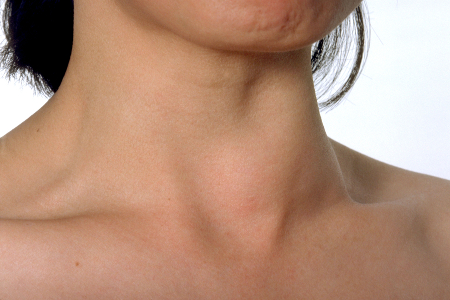
Laboratory assessment
Patients presenting with thyroid nodules are usually euthyroid. This should be confirmed by a serum TSH level.[2]Gharib H, Papini E, Garber JR, et al. AMERICAN ASSOCIATION OF CLINICAL ENDOCRINOLOGISTS, AMERICAN COLLEGE OF ENDOCRINOLOGY, AND ASSOCIAZIONE MEDICI ENDOCRINOLOGI medical guidelines for clinical practice for the diagnosis and management of thyroid nodules - 2016 update. Endocr Pract. 2016 May;22(5):622-39.
https://www.endocrinepractice.org/article/S1530-891X(20)42954-4/fulltext
http://www.ncbi.nlm.nih.gov/pubmed/27167915?tool=bestpractice.com
[38]National Institute for Health and Care Excellence. Thyroid disease: assessment and management. Oct 2023 [internet publication].
https://www.nice.org.uk/guidance/ng145
If the TSH is below normal (suppressed), further assessment with free thyroxine (FT4) and calculated or free triiodothyronine (FT3) should be performed to confirm hyperthyroidism. Some practitioners prefer to order TSH and FT4 as a paired set.
Consider asking patients about their biotin (vitamin B7) intake, as a high consumption from dietary supplements may lead to falsely high or low thyroid function test results.[38]National Institute for Health and Care Excellence. Thyroid disease: assessment and management. Oct 2023 [internet publication].
https://www.nice.org.uk/guidance/ng145
[42]Samarasinghe S, Meah F, Singh V, et al. Biotin interference with routine clinical immunoassays: understand the causes and mitigate the risks. Endocr Pract. 2017 Aug;23(8):989-98.
http://www.ncbi.nlm.nih.gov/pubmed/28534685?tool=bestpractice.com
[43]Li D, Ferguson A, Cervinski MA, et al. AACC guidance document on biotin interference in laboratory tests. J Appl Lab Med. 2020 May 1;5(3):575-87.
https://academic.oup.com/jalm/article/5/3/575/5700349
http://www.ncbi.nlm.nih.gov/pubmed/32445355?tool=bestpractice.com
Hyperthyroidism in the setting of thyroid nodules may suggest the presence of one or more hyperfunctioning (autonomous) adenomas and the risk of malignancy in such nodules is very low.[2]Gharib H, Papini E, Garber JR, et al. AMERICAN ASSOCIATION OF CLINICAL ENDOCRINOLOGISTS, AMERICAN COLLEGE OF ENDOCRINOLOGY, AND ASSOCIAZIONE MEDICI ENDOCRINOLOGI medical guidelines for clinical practice for the diagnosis and management of thyroid nodules - 2016 update. Endocr Pract. 2016 May;22(5):622-39.
https://www.endocrinepractice.org/article/S1530-891X(20)42954-4/fulltext
http://www.ncbi.nlm.nih.gov/pubmed/27167915?tool=bestpractice.com
If the thyroid is diffusely enlarged, Graves disease or thyroiditis should be suspected. Radioactive iodine uptake and scan will typically differentiate between these conditions and should be withheld until FT4/TSH is first tested.[36]Agrawal K, Weaver J, Ngu R, et al. Clinical significance of patterns of incidental thyroid uptake at (18)F-FDG PET/CT. Clin Radiol. 2015 May;70(5):536-43.
http://www.ncbi.nlm.nih.gov/pubmed/25687827?tool=bestpractice.com
If the TSH is elevated, further assessment with FT4 and autoantibodies (with Hashimoto thyroiditis being considered) should be performed.
Serum calcium (total and ionized) and intact parathyroid hormone levels may be assessed if the imaging characteristics of the nodule or neck mass are suggestive of an enlarged parathyroid gland.[2]Gharib H, Papini E, Garber JR, et al. AMERICAN ASSOCIATION OF CLINICAL ENDOCRINOLOGISTS, AMERICAN COLLEGE OF ENDOCRINOLOGY, AND ASSOCIAZIONE MEDICI ENDOCRINOLOGI medical guidelines for clinical practice for the diagnosis and management of thyroid nodules - 2016 update. Endocr Pract. 2016 May;22(5):622-39.
https://www.endocrinepractice.org/article/S1530-891X(20)42954-4/fulltext
http://www.ncbi.nlm.nih.gov/pubmed/27167915?tool=bestpractice.com
Serum calcitonin levels should be obtained in patients with a family history of medullary thyroid carcinoma and multiple endocrine neoplasia type II. However, checking calcitonin for the routine evaluation of thyroid nodules has not been routinely recommended.[1]Haugen BR, Alexander EK, Bible KC, et al. 2015 American Thyroid Association management guidelines for adult patients with thyroid nodules and differentiated thyroid cancer. Thyroid. 2016 Jan;26(1):1-133.
https://www.ncbi.nlm.nih.gov/pmc/articles/PMC4739132
http://www.ncbi.nlm.nih.gov/pubmed/26462967?tool=bestpractice.com
[34]National Institute for Health and Care Excellence. Thyroid cancer: assessment and management. Dec 2022 [internet publication].
https://www.nice.org.uk/guidance/ng230
[44]Verbeek HH, de Groot JWB, Sluiter WJ, et al. Calcitonin testing for detection of medullary thyroid cancer in people with thyroid nodules. Cochrane Database Syst Rev. 2020 Mar 16;3(3):CD010159.
https://www.cochranelibrary.com/cdsr/doi/10.1002/14651858.CD010159.pub2/full
http://www.ncbi.nlm.nih.gov/pubmed/32176812?tool=bestpractice.com
[  ]
What is the accuracy of basal calcitonin for detection of medullary thyroid cancer in people with nodular thyroid disease?/cca.html?targetUrl=https://www.cochranelibrary.com/cca/doi/10.1002/cca.3232/fullShow me the answer
]
What is the accuracy of basal calcitonin for detection of medullary thyroid cancer in people with nodular thyroid disease?/cca.html?targetUrl=https://www.cochranelibrary.com/cca/doi/10.1002/cca.3232/fullShow me the answer
Ultrasonography
Cervical ultrasonography is the initial imaging study of choice for thyroid nodules as well as many other anatomic lesions in the neck.[33]American College of Radiology. ACR–AIUM–SPR–SRU practice parameter for the performance and interpretation of diagnostic ultrasound of the thyroid and extracranial head and neck. 2022 [internet publication].
https://www.acr.org/-/media/ACR/Files/Practice-Parameters/ExtracranialHeadandNeck.pdf
Ultrasonography can detect and characterize nodules too small to be palpable, and provide exact dimensions to facilitate serial monitoring.[2]Gharib H, Papini E, Garber JR, et al. AMERICAN ASSOCIATION OF CLINICAL ENDOCRINOLOGISTS, AMERICAN COLLEGE OF ENDOCRINOLOGY, AND ASSOCIAZIONE MEDICI ENDOCRINOLOGI medical guidelines for clinical practice for the diagnosis and management of thyroid nodules - 2016 update. Endocr Pract. 2016 May;22(5):622-39.
https://www.endocrinepractice.org/article/S1530-891X(20)42954-4/fulltext
http://www.ncbi.nlm.nih.gov/pubmed/27167915?tool=bestpractice.com
Ultrasonography is used extensively in the evaluation of central or lateral neck lymphadenopathy.[2]Gharib H, Papini E, Garber JR, et al. AMERICAN ASSOCIATION OF CLINICAL ENDOCRINOLOGISTS, AMERICAN COLLEGE OF ENDOCRINOLOGY, AND ASSOCIAZIONE MEDICI ENDOCRINOLOGI medical guidelines for clinical practice for the diagnosis and management of thyroid nodules - 2016 update. Endocr Pract. 2016 May;22(5):622-39.
https://www.endocrinepractice.org/article/S1530-891X(20)42954-4/fulltext
http://www.ncbi.nlm.nih.gov/pubmed/27167915?tool=bestpractice.com
[34]National Institute for Health and Care Excellence. Thyroid cancer: assessment and management. Dec 2022 [internet publication].
https://www.nice.org.uk/guidance/ng230
Frequently, inflammation (e.g., subacute thyroiditis, Hashimoto thyroiditis, and chronic thyroiditis) may lead to a heterogeneous echotexture of the thyroid gland that may, in conjunction with associated lymphadenopathy, be suggestive of the diagnosis. Inflammation may also lead to the formation of pseudonodules, which are indistinctly demarcated areas that arise due to focal heterogeneity but are not true nodular lesions. These lesions disappear on ultrasound when the transducer is turned 90 degrees to where the pseudonodule is visualized. Pseudonodules do not require FNA and in the setting of thyroiditis should be followed expectantly to see if they regress once the thyroiditis resolves.
Size and sonographic features of the nodule determine whether further evaluation with FNA is warranted.[35]Durante C, Hegedüs L, Czarniecka A, et al. 2023 European Thyroid Association clinical practice guidelines for thyroid nodule management. Eur Thyroid J. 2023 Oct 1;12(5).
https://etj.bioscientifica.com/view/journals/etj/12/5/ETJ-23-0067.xml
http://www.ncbi.nlm.nih.gov/pubmed/37358008?tool=bestpractice.com
[45]Tessler FN, Middleton WD, Grant EG, et al. ACR Thyroid Imaging, Reporting and Data System (TI-RADS): white paper of the ACR TI-RADS committee. J Am Coll Radiol. 2017 May;14(5):587-95.
https://www.jacr.org/article/S1546-1440(17)30186-2/fulltext
http://www.ncbi.nlm.nih.gov/pubmed/28372962?tool=bestpractice.com
Malignancy cannot be definitively diagnosed or excluded with ultrasonography. However, the presence of the ultrasonographic features noted below should raise the level of suspicion about malignancy and the need for FNA biopsy:[45]Tessler FN, Middleton WD, Grant EG, et al. ACR Thyroid Imaging, Reporting and Data System (TI-RADS): white paper of the ACR TI-RADS committee. J Am Coll Radiol. 2017 May;14(5):587-95.
https://www.jacr.org/article/S1546-1440(17)30186-2/fulltext
http://www.ncbi.nlm.nih.gov/pubmed/28372962?tool=bestpractice.com
Threshold size for FNA depends on the sonographic characteristics, but usually exceeds 1 cm. FNA biopsy of smaller nodules should be considered if there is a high-risk history or suspicious sonographic appearance. Observation of some of these lesions may merit discussion between the physician and the patient in selected cases.
FNA biopsy of palpable and incidentally discovered solid thyroid nodules without high-risk history of sonographic features should be considered if the size is ≥1 cm. Mixed cystic and solid nodules with no suspicious features and spongiform nodules ≥2 cm should be evaluated with FNA.[1]Haugen BR, Alexander EK, Bible KC, et al. 2015 American Thyroid Association management guidelines for adult patients with thyroid nodules and differentiated thyroid cancer. Thyroid. 2016 Jan;26(1):1-133.
https://www.ncbi.nlm.nih.gov/pmc/articles/PMC4739132
http://www.ncbi.nlm.nih.gov/pubmed/26462967?tool=bestpractice.com
A nodule that has been biopsied previously but has increased in size >50% on a follow-up study should also be considered for re-biopsy.[1]Haugen BR, Alexander EK, Bible KC, et al. 2015 American Thyroid Association management guidelines for adult patients with thyroid nodules and differentiated thyroid cancer. Thyroid. 2016 Jan;26(1):1-133.
https://www.ncbi.nlm.nih.gov/pmc/articles/PMC4739132
http://www.ncbi.nlm.nih.gov/pubmed/26462967?tool=bestpractice.com
All lymph nodes suspicious for locally metastatic thyroid cancer should be biopsied if that will change the treatment plan, as should lymph nodes in a location close to the trachea or carotid artery that may present a risk for complication if left untreated. However, in some circumstances, lymph nodes may just be observed.
[Figure caption and citation for the preceding image starts]: Nodule sonographic characteristics and threshold size for fine needle aspiration (FNA).Created by the BMJ Knowledge Centre and Dr B.C. Stack Jr; adapted from Haugen BR et al. Thyroid 2016 Jan;26(1):1-133 [Citation ends].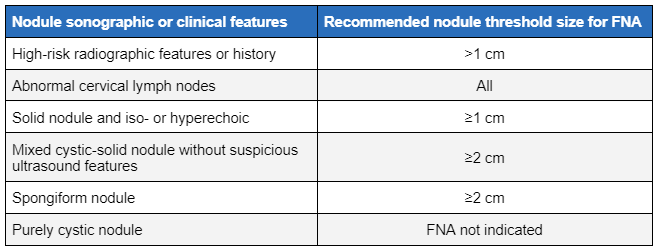 [Figure caption and citation for the preceding image starts]: Ultrasound image of thyroid noduleCourtesy of Getty images; used with permission [Citation ends].
[Figure caption and citation for the preceding image starts]: Ultrasound image of thyroid noduleCourtesy of Getty images; used with permission [Citation ends].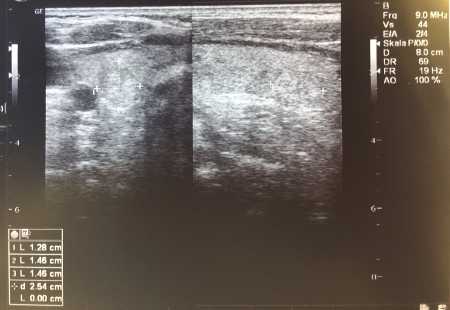
TI-RADS calculator: chart showing five categories on the basis of the ACR Thyroid Imaging, Reporting and Data System (TI-RADS) lexicon, TR levels, and criteria for fine-needle aspiration or follow-up ultrasound. Adapted from Tessler FN et al. J Am Coll Radiol 2017 May;14(5):587-95
Opens in new window
The American College of Radiology (ACR) Thyroid Imaging, Reporting and Data System (TI-RADS) lexicon categorizes the ultrasound features as benign, minimally suspicious, moderately suspicious, or highly suspicious for malignancy. This helps guide the decision as to whether follow-up ultrasound or FNA is required.[45]Tessler FN, Middleton WD, Grant EG, et al. ACR Thyroid Imaging, Reporting and Data System (TI-RADS): white paper of the ACR TI-RADS committee. J Am Coll Radiol. 2017 May;14(5):587-95.
https://www.jacr.org/article/S1546-1440(17)30186-2/fulltext
http://www.ncbi.nlm.nih.gov/pubmed/28372962?tool=bestpractice.com
Radioisotope imaging
If TSH is suppressed, radioisotope imaging should be performed to identify autonomously hyperfunctioning ("hot") nodules and to distinguish between Graves disease and thyroiditis. A thyroid nodule that exhibits focally increased radioisotope uptake with suppression of the surrounding thyroid parenchyma has a risk of malignancy of less than 2%.[3]Alexander EK, Cibas ES. Diagnosis of thyroid nodules. Lancet Diabetes Endocrinol. 2022 Jul;10(7):533-9.
http://www.ncbi.nlm.nih.gov/pubmed/35752200?tool=bestpractice.com
A radioisotope scan showing such a "hot" nodule obviates the need to perform FNA if there are no other suspicious features or history.[2]Gharib H, Papini E, Garber JR, et al. AMERICAN ASSOCIATION OF CLINICAL ENDOCRINOLOGISTS, AMERICAN COLLEGE OF ENDOCRINOLOGY, AND ASSOCIAZIONE MEDICI ENDOCRINOLOGI medical guidelines for clinical practice for the diagnosis and management of thyroid nodules - 2016 update. Endocr Pract. 2016 May;22(5):622-39.
https://www.endocrinepractice.org/article/S1530-891X(20)42954-4/fulltext
http://www.ncbi.nlm.nih.gov/pubmed/27167915?tool=bestpractice.com
The use of radioisotope scanning for identification of "cold" nodules as a means of risk stratification is no longer recommended because it does not offer additional advantages over ultrasound and FNA in differentiating malignant from benign lesions.[46]Khalid AN, Hollenbeak CS, Quraishi SA, et al. The cost-effectiveness of iodine 131 scintigraphy, ultrasonography, and fine-needle aspiration biopsy in the initial diagnosis of solitary thyroid nodules. Arch Otolaryngol Head Neck Surg. 2006 Mar;132(3):244-50.
http://archotol.jamanetwork.com/article.aspx?articleid=484122
http://www.ncbi.nlm.nih.gov/pubmed/16549743?tool=bestpractice.com
[Figure caption and citation for the preceding image starts]: Iodine uptake scans: typical appearances of absent uptake in thyroiditis (top panel); diffuse increased uptake in Grave’s disease (lower left panel); areas of increased and decreased uptake in toxic multinodular goitre (lower middle panel); single area of increased uptake in a toxic adenoma (lower right panel)Courtesy of Dr Petros Perros [Citation ends].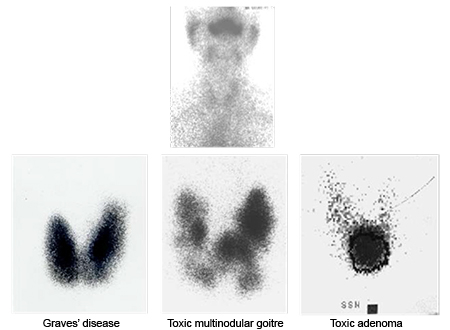
Computed tomography (CT) and magnetic resonance imaging (MRI)
Neither CT nor MRI (cross-sectional imaging) has a primary role in the initial evaluation of a thyroid nodule; however, they can be used for accurate measurement and assessment of the size of large substernal goiters and they may identify lymph nodes that cannot be visualized by ultrasound.[2]Gharib H, Papini E, Garber JR, et al. AMERICAN ASSOCIATION OF CLINICAL ENDOCRINOLOGISTS, AMERICAN COLLEGE OF ENDOCRINOLOGY, AND ASSOCIAZIONE MEDICI ENDOCRINOLOGI medical guidelines for clinical practice for the diagnosis and management of thyroid nodules - 2016 update. Endocr Pract. 2016 May;22(5):622-39.
https://www.endocrinepractice.org/article/S1530-891X(20)42954-4/fulltext
http://www.ncbi.nlm.nih.gov/pubmed/27167915?tool=bestpractice.com
They are also helpful in cases of large goiters with posterior extension and diffuse bulky adenopathy.
Administration of iodinated contrast for CT scanning should be carefully considered because it often prevents subsequent diagnostic and therapeutic use of radioactive iodine for 4 to 8 weeks or longer. Iodinated contrast can also induce the Jod-Basedow effect (iodine-induced hyperthyroidism) and exacerbate hyperthyroidism in the presence of underlying Graves disease or toxic adenoma(s). If there is concern about therapeutic use of radioactive iodine following administration of iodinated contrast for CT, a 24-hour urine collection can be performed and urine iodine measured.
Positron emission tomography (PET)
Fluorodeoxyglucose (FDG)-PET scans appear to have relatively high sensitivity but low specificity for malignancy, and results vary.[47]Hales NW, Krempl GA, Medina JE. Is there a role for fluorodeoxyglucose positron emission tomography/computed tomography in cytologically indeterminate thyroid nodules? Am J Otolaryngol. 2008 Mar-Apr;29(2):113-8.
http://www.ncbi.nlm.nih.gov/pubmed/18314022?tool=bestpractice.com
Therefore, FDG-PET is not recommended during the initial evaluation of a nodule. However, any FDG-avid thyroid nodule found incidentally deserves a thorough evaluation for malignancy.[48]Piek MW, de Boer JP, Vriens MR, et al. Retrospective analyses of (18)FDG-PET/CT thyroid incidentaloma in adults: incidence, treatment, and outcome in a tertiary cancer referral center. Thyroid. 2021 Nov;31(11):1715-22.
http://www.ncbi.nlm.nih.gov/pubmed/34340567?tool=bestpractice.com
[49]Ayan A, Basaran Y, Kirnap NG, et al. Synchronous thyroid cancer on the edge: incidentalomas of 18F-FDG PET/CT in clinical practice. Niger J Clin Pract. 2021 Jun;24(6):937-42.
http://www.ncbi.nlm.nih.gov/pubmed/34121744?tool=bestpractice.com
[50]Adas M, Adas G, Koc B, et al. Incidental thyroid lesions on FDG-PET/CT: a prevalence study and proposition of management. Minerva Endocrinol. 2015 Sep;40(3):169-75.
http://www.ncbi.nlm.nih.gov/pubmed/26205646?tool=bestpractice.com
The evaluation should include neck ultrasonography followed by FNA if indicated, based on patient's history and the nodule imaging characteristics.[51]Boeckmann J, Bartel T, Siegel E, et al. Can the pathology of a thyroid nodule be determined by positron emission tomography uptake? Otolaryngol Head Neck Surg. 2012 Jun;146(6):906-12.
http://www.ncbi.nlm.nih.gov/pubmed/22307576?tool=bestpractice.com
Homogeneous diffuse PET uptake by the thyroid gland rarely indicates thyroid cancer: it is usually seen in chronic lymphocytic (Hashimoto) thyroiditis.[36]Agrawal K, Weaver J, Ngu R, et al. Clinical significance of patterns of incidental thyroid uptake at (18)F-FDG PET/CT. Clin Radiol. 2015 May;70(5):536-43.
http://www.ncbi.nlm.nih.gov/pubmed/25687827?tool=bestpractice.com
Fine needle aspiration (FNA) biopsy
Following ultrasonography, ultrasound-guided FNA is the procedure of choice for evaluation of suspicious thyroid nodules.[34]National Institute for Health and Care Excellence. Thyroid cancer: assessment and management. Dec 2022 [internet publication].
https://www.nice.org.uk/guidance/ng230
Cytology and adjunctive molecular genetic testing may determine whether surgery is indicated. The procedure is well tolerated and carries a very low risk of complications. Local pain and hematoma are the most common complications, while serious adverse events are rare.[52]Park JY, Choi W, Hong AR, et al. A comprehensive assessment of the harms of fine-needle aspiration biopsy for thyroid nodules: a systematic review. Endocrinol Metab (Seoul). 2023 Feb;38(1):104-16.
https://www.e-enm.org/journal/view.php?doi=10.3803/EnM.2023.1669
http://www.ncbi.nlm.nih.gov/pubmed/36891657?tool=bestpractice.com
FNA allows for improved diagnostic accuracy, a higher malignancy yield at the time of surgery, and significant cost reductions.[53]Gharib H, Papini E. Thyroid nodules: clinical importance, assessment, and treatment. Endocrinol Metab Clin North Am. 2007 Sep;36(3):707-35.
http://www.ncbi.nlm.nih.gov/pubmed/17673125?tool=bestpractice.com
Use of ultrasound guidance for needle localization has been shown to decrease the rate of inadequate specimens compared with unguided FNA.[54]Cesur M, Corapcioglu D, Bulut S, et al. Comparison of palpation-guided fine-needle aspiration biopsy to ultrasound-guided fine-needle aspiration biopsy in the evaluation of thyroid nodules. Thyroid. 2006 Jun;16(6):555-61.
http://www.ncbi.nlm.nih.gov/pubmed/16839257?tool=bestpractice.com
High-quality cytology smears are essential for diagnosis and must be technically adequate with well-prepared cellular material and colloid for a satisfactory evaluation. Cytopathology from the FNA is reported as either unsatisfactory, benign, indeterminate, suspicious, or malignant. Approximately 10% to 20% of cytology results are reported as unsatisfactory or inadequate, 60% to 75% are reported as benign, and 6% to 10% are reported as suspicious or malignant.[55]Theoharis CG, Schofield KM, Hammers L, et al. The Bethesda thyroid fine-needle aspiration classification system: year 1 at an academic institution. Thyroid. 2009 Nov;19(11):1215-23.
http://www.ncbi.nlm.nih.gov/pubmed/19888859?tool=bestpractice.com
[56]Jo VY, Stelow EB, Dustin SM, et al. Malignancy risk for fine-needle aspiration of thyroid lesions according to the Bethesda system for reporting thyroid cytopathology. Am J Clin Pathol. 2010 Sep;134(3):450-6.
http://www.ncbi.nlm.nih.gov/pubmed/20716802?tool=bestpractice.com
The exact terminology varies among pathology departments. This prompted the development of the Bethesda classification system, which is commonly used, and was updated in 2017.The Bethesda classification system includes recommended diagnostic categories, implied risk of malignancy, and recommended clinical management. The categories are designated as: nondiagnostic or unsatisfactory; benign; atypia of undetermined significance or follicular lesion of undetermined significance; follicular neoplasm or suspicious for a follicular neoplasm; suspicious for malignancy; and malignant.[57]Cibas ES, Ali SZ. The 2017 Bethesda system for reporting thyroid cytopathology. Thyroid. 2017 Nov;27(11):1341-6.
https://www.liebertpub.com/doi/10.1089/thy.2017.0500
http://www.ncbi.nlm.nih.gov/pubmed/29091573?tool=bestpractice.com
Actual management may depend on other factors (e.g., clinical, sonographic) besides the FNA interpretation.[57]Cibas ES, Ali SZ. The 2017 Bethesda system for reporting thyroid cytopathology. Thyroid. 2017 Nov;27(11):1341-6.
https://www.liebertpub.com/doi/10.1089/thy.2017.0500
http://www.ncbi.nlm.nih.gov/pubmed/29091573?tool=bestpractice.com
[58]Bumpous J, Celestre MD, Pribitkin E, et al. Decision making for diagnosis and management: algorithms from experts for molecular testing. Otolaryngol Clin North Am. 2014 Aug;47(4):609-23.
http://www.ncbi.nlm.nih.gov/pubmed/25041961?tool=bestpractice.com
Unsatisfactory cytology results require repeat FNA. A second attempt at ultrasound-guided FNA will produce a satisfactory diagnostic specimen in up to 75% of solid nodules and 50% of cystic nodules.[59]Alexander EK, Heering JP, Benson CB, et al. Assessment of nondiagnostic ultrasound-guided fine needle aspirations of thyroid nodules. J Clin Endocrinol Metab. 2002 Nov;87(11):4924-7.
https://academic.oup.com/jcem/article/87/11/4924/2823099
http://www.ncbi.nlm.nih.gov/pubmed/12414851?tool=bestpractice.com
If the results are still unsatisfactory after 2 attempts, consideration should be given to observation or a diagnostic lobectomy (hemithyroidectomy).
Cytologically benign, noncystic lesions on FNA may still have up to a 5% risk of malignancy that may be even higher in nodules ≥4 cm (probably from sampling error). Such nodules therefore still require follow-up with annual neck examination and neck ultrasonography.[60]Chehade JM, Silverberg AB, Kim J, et al. Role of repeated fine-needle aspiration of thyroid nodules with benign cytologic features. Endocr Pract. 2001 Jul-Aug;7(4):237-43.
http://www.ncbi.nlm.nih.gov/pubmed/11497473?tool=bestpractice.com
Aspirated cyst contents often produce cytologic results interpreted as inadequate or indeterminate because of the lack of cellular content and absence of colloid. Most cystic nodules are complex (solid-cystic). Pure cysts do not generally need FNA unless symptomatic, because the risk of malignancy is extremely low, but where an unsatisfactory or indeterminate cytologic aspirate is obtained from a pure cyst it may be managed conservatively and further intervention is not usually required.
Nodules with a Bethesda criteria cytologic diagnosis of atypia of undetermined significance/follicular lesion of undetermined significance or equivalent may be considered for repeat FNA after 4 to 6 weeks to allow for healing of the previous FNA tract.[61]Baloch ZW, Cibas ES, Clark DP, et al. The National Cancer Institute Thyroid fine needle aspiration state of the science conference: a summation. Cytojournal. 2008 Apr 7;5:6.
https://www.ncbi.nlm.nih.gov/pmc/articles/PMC2365970
http://www.ncbi.nlm.nih.gov/pubmed/18394201?tool=bestpractice.com
Patients with follicular neoplasms suspicious for malignancy or malignant cytology should be referred to an experienced endocrine or head and neck surgeon for further management.
Classification systems are also available from the American Thyroid Association and the British Thyroid Association and map to the Bethesda categories.[1]Haugen BR, Alexander EK, Bible KC, et al. 2015 American Thyroid Association management guidelines for adult patients with thyroid nodules and differentiated thyroid cancer. Thyroid. 2016 Jan;26(1):1-133.
https://www.ncbi.nlm.nih.gov/pmc/articles/PMC4739132
http://www.ncbi.nlm.nih.gov/pubmed/26462967?tool=bestpractice.com
[62]British Thyroid Association. Guidelines for the management of thyroid cancer. July 2014 [internet publication].
http://onlinelibrary.wiley.com/doi/10.1111/cen.12515/pdf
Use of molecular markers with FNA
Well-described point mutations, such as BRAF V600E, NRAS61, HRAS61, KRAS12/13, and RET/PTC and PAX8/PPARγ rearrangements, have been associated with thyroid cancer. The emerging use of molecular testing to assist in interpretation of FNA samples has been shown to increase the diagnostic accuracy and yield of the cytology results.[63]Nishino M, Nikiforova M. Update on molecular testing for cytologically indeterminate thyroid nodules. Arch Pathol Lab Med. 2018 Apr;142(4):446-57.
https://meridian.allenpress.com/aplm/article/142/4/446/194316/Update-on-Molecular-Testing-for-Cytologically
http://www.ncbi.nlm.nih.gov/pubmed/29336606?tool=bestpractice.com
When available, molecular testing is especially helpful in the evaluation of indeterminate cytology results where the presence of one of the above-noted mutations or rearrangements significantly increases the likelihood of malignancy.[57]Cibas ES, Ali SZ. The 2017 Bethesda system for reporting thyroid cytopathology. Thyroid. 2017 Nov;27(11):1341-6.
https://www.liebertpub.com/doi/10.1089/thy.2017.0500
http://www.ncbi.nlm.nih.gov/pubmed/29091573?tool=bestpractice.com
[64]Hu MI, Waguespack SG, Dosiou C, et al. Afirma Genomic Sequencing Classifier and Xpression Atlas molecular findings in consecutive Bethesda III-VI thyroid nodules. J Clin Endocrinol Metab. 2021 Jul 13;106(8):2198-207.
https://academic.oup.com/jcem/article/106/8/2198/6278308
http://www.ncbi.nlm.nih.gov/pubmed/34009369?tool=bestpractice.com
The presence of a positive molecular test may, therefore, alter medical decision making in favor of upfront thyroidectomy as the most appropriate treatment choice. However, while most papillary and follicular thyroid cancers contain one of these mutations, the absence of a mutation cannot exclude malignancy.[1]Haugen BR, Alexander EK, Bible KC, et al. 2015 American Thyroid Association management guidelines for adult patients with thyroid nodules and differentiated thyroid cancer. Thyroid. 2016 Jan;26(1):1-133.
https://www.ncbi.nlm.nih.gov/pmc/articles/PMC4739132
http://www.ncbi.nlm.nih.gov/pubmed/26462967?tool=bestpractice.com
If molecular testing is not available, a standard diagnostic approach typically involving diagnostic lobectomy (hemithyroidectomy) to resolve cytologically ambiguous or indeterminate cases is necessary.
Surgical diagnosis
Diagnostic lobectomy (hemithyroidectomy) should be considered for definitive histologic diagnosis following two or more unsatisfactory or indeterminate FNA biopsies; these patients have a higher risk of malignancy than the general rate for all thyroid nodules.[1]Haugen BR, Alexander EK, Bible KC, et al. 2015 American Thyroid Association management guidelines for adult patients with thyroid nodules and differentiated thyroid cancer. Thyroid. 2016 Jan;26(1):1-133.
https://www.ncbi.nlm.nih.gov/pmc/articles/PMC4739132
http://www.ncbi.nlm.nih.gov/pubmed/26462967?tool=bestpractice.com
Total thyroidectomy is recommended for some patients with malignant cytology depending on lesion size, lymphadenopathy, anticipated need for postoperative radioiodine, and other coexisting thyroid nodular disease.[1]Haugen BR, Alexander EK, Bible KC, et al. 2015 American Thyroid Association management guidelines for adult patients with thyroid nodules and differentiated thyroid cancer. Thyroid. 2016 Jan;26(1):1-133.
https://www.ncbi.nlm.nih.gov/pmc/articles/PMC4739132
http://www.ncbi.nlm.nih.gov/pubmed/26462967?tool=bestpractice.com
Nodules with indeterminate or suspicious cytology results should undergo a multidisciplinary evaluation by a surgeon and endocrinologist to determine optimal next steps.
Surgery is also indicated if a nodule is symptomatic because of compression of nearby structures such as the trachea or esophagus. CT, MRI, and loop spirometry may be useful adjunctive methods for evaluation of the degree of compression. Removal of nodules of 4 cm or larger is recommended because the false-negative rate of FNA for detection of malignancy has been reported to be 13% from sampling error.[65]McCoy KL, Jabbour N, Ogilvie JB, et al. The incidence of cancer and rate of false-negative cytology in thyroid nodules greater than or equal to 4 cm in size. Surgery. 2007 Dec;142(6):837-44.
http://www.ncbi.nlm.nih.gov/pubmed/18063065?tool=bestpractice.com
However, FNA may still be useful in evaluation of large nodules because preoperative confirmation of malignant or suspicious cytology will enable optimal planning for the extent of surgery.
All patients undergoing thyroid surgery should have a preoperative voice assessment; a preoperative laryngeal examination is recommended for patients with preoperative voice abnormalities.[1]Haugen BR, Alexander EK, Bible KC, et al. 2015 American Thyroid Association management guidelines for adult patients with thyroid nodules and differentiated thyroid cancer. Thyroid. 2016 Jan;26(1):1-133.
https://www.ncbi.nlm.nih.gov/pmc/articles/PMC4739132
http://www.ncbi.nlm.nih.gov/pubmed/26462967?tool=bestpractice.com
[Figure caption and citation for the preceding image starts]: Algorithm for the evaluation of a thyroid massCreated by the BMJ Knowledge Centre and Dr B.C. Stack Jr (FNA, fine needle aspiration; PTH, parathyroid hormone; TSH, thyroid-stimulating hormone) [Citation ends].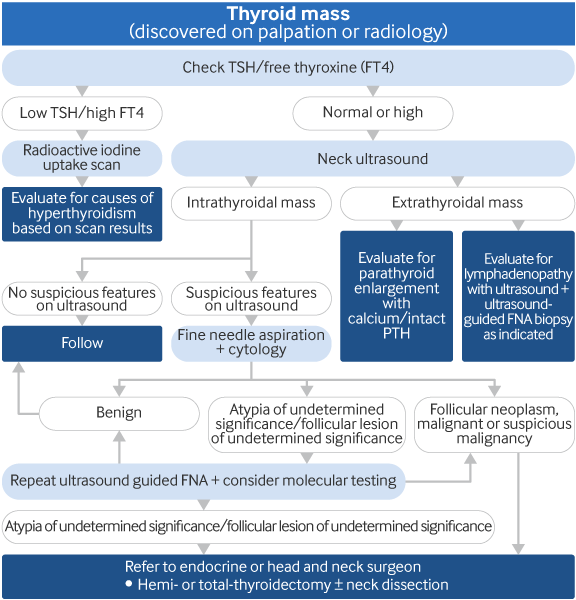
Risk stratification
The concept of risk stratification of patients presenting with thyroid nodules that end in a malignant cytologic diagnosis is key to understanding the management approach for thyroid cancer.[1]Haugen BR, Alexander EK, Bible KC, et al. 2015 American Thyroid Association management guidelines for adult patients with thyroid nodules and differentiated thyroid cancer. Thyroid. 2016 Jan;26(1):1-133.
https://www.ncbi.nlm.nih.gov/pmc/articles/PMC4739132
http://www.ncbi.nlm.nih.gov/pubmed/26462967?tool=bestpractice.com
[18]Garber JR, Papini E, Frasoldati A, et al. American Association of Clinical Endocrinology and Associazione Medici Endocrinologi thyroid nodule algorithmic tool. Endocr Pract. 2021 Jul;27(7):649-60.
https://www.endocrinepractice.org/article/S1530-891X(21)00164-6/fulltext#secsectitle0130
http://www.ncbi.nlm.nih.gov/pubmed/34090820?tool=bestpractice.com
[66]Kim DH, Kim SW, Basurrah MA, et al. Diagnostic performance of six ultrasound risk stratification systems for thyroid nodules: a systematic review and network meta-analysis. AJR Am J Roentgenol. 2023 Jun;220(6):791-803.
https://www.ajronline.org/doi/10.2214/AJR.22.28556
http://www.ncbi.nlm.nih.gov/pubmed/36752367?tool=bestpractice.com
This can be achieved with preoperative imaging or with additional data from postoperative pathology.[45]Tessler FN, Middleton WD, Grant EG, et al. ACR Thyroid Imaging, Reporting and Data System (TI-RADS): white paper of the ACR TI-RADS committee. J Am Coll Radiol. 2017 May;14(5):587-95.
https://www.jacr.org/article/S1546-1440(17)30186-2/fulltext
http://www.ncbi.nlm.nih.gov/pubmed/28372962?tool=bestpractice.com
This process serves as an objective way of prescribing the level of vigilance and extent of surgical resection or ablation to patients with thyroid cancer, and has been illustrated based upon an escalating scale of known risks.

 ]
]
 [Figure caption and citation for the preceding image starts]: Ultrasound image of thyroid noduleCourtesy of Getty images; used with permission [Citation ends].
[Figure caption and citation for the preceding image starts]: Ultrasound image of thyroid noduleCourtesy of Getty images; used with permission [Citation ends].

